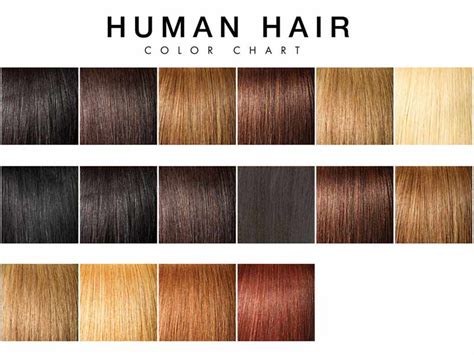Introduction
The human hair spectrum is a kaleidoscope of colors, with each shade telling a story of ancestry, genetics, and individuality. Understanding the intricate science behind hair color can empower you to enhance your natural beauty and express your unique style.

The Chemistry of Hair Color
The key to understanding human hair color lies in the pigment melanin. Melanin is a natural substance produced by specialized cells in the hair follicles. Two main types of melanin exist:
- Eumelanin: Responsible for brown and black hair colors
- Pheomelanin: Associated with red and blonde hair shades
The amount and ratio of eumelanin and pheomelanin in your hair determine its specific color. For instance, high levels of eumelanin result in darker shades, while a predominance of pheomelanin creates lighter hues.
Genetic Inheritance
The genetic makeup inherited from your parents plays a crucial role in determining your hair color. Genes influence the activity of the cells that produce melanin, affecting the quantity and ratio of eumelanin to pheomelanin.
The Fitzpatrick Scale
The Fitzpatrick Scale is a widely used tool for classifying skin tones and hair colors. It categorizes individuals into six types based on their response to ultraviolet radiation:
| Fitzpatrick Type | Hair Color |
|---|---|
| Type I | Red or blonde |
| Type II | Light brown |
| Type III | Dark brown |
| Type IV | Black |
| Type V | Brown or black |
| Type VI | Dark brown or black |
Regional Variations
The distribution of human hair colors varies significantly across regions. For example:
- Europe: Brown hair is most common, followed by blonde and black.
- Asia: Black hair is predominant, with varying shades of brown and red.
- Africa: Black hair is almost universal, with occasional variations in brown and red.
Cultural Significance
Hair color has profound cultural significance in many societies. It can represent beauty, status, tribe, or religious affiliation. For instance:
- Ancient Egypt: Blonde and red hair were associated with royalty and gods.
- Medieval Europe: Fair hair was considered a symbol of innocence and purity.
- Modern China: Black hair is traditionally favored for its association with luck and prosperity.
Health Implications
Hair color can provide insights into certain health conditions. For example:
- Premature Graying: Rapid hair graying can indicate underlying thyroid issues or vitamin B12 deficiency.
- Red Hair: Redheads may be more prone to melanoma and Parkinson’s disease due to a mutation in the MC1R gene.
Hair Color and Psychology
Studies have suggested that hair color may influence our perception and assessment of others. For instance:
- Brunettes: Often perceived as trustworthy, reliable, and serious.
- Blondes: May be viewed as outgoing, approachable, and fun-loving.
- Redheads: Frequently associated with passion, creativity, and fiery personalities.
Hair Color Trends
Fashion and society influence hair color trends. Current popular shades include:
- Ombre: Gradual transition from dark roots to lighter ends.
- Balayage: Freehand hair painting technique that creates natural-looking highlights.
- Platinum Blonde: A highly sought-after ultra-light blonde shade.
- Copper: Warm and vibrant red-orange hair color.
Hair Dye and Styling
Hair dyeing and styling can dramatically alter hair color. Chemical treatments like bleach, permanent dyes, and toners allow for customizable hair transformations. However, these treatments can also damage hair, requiring proper care and maintenance.
Natural Hair Color Enhancers
If you prefer to enhance your natural hair color without dyes, consider the following:
- Henna: A plant-based dye that imparts a reddish-brown hue.
- Lemon Juice: A natural lightener that can subtly brighten hair.
- Chamomile Tea: A mild bleach that adds golden highlights.
Benefits of Understanding Hair Color
Understanding the science, genetics, and cultural significance of human hair color offers numerous benefits:
- Personalized Hairstyles: Choose hair colors that complement your facial features and skin tone.
- Health Monitoring: Hair color can provide clues about potential health issues.
- Cultural Appreciation: Gain insights into the diverse cultural meanings associated with hair color.
- Empowerment: Express your individuality and creativity through hair color choices.
Conclusion
The human hair spectrum is a vibrant tapestry of shades, each with its own unique story. By delving into the chemistry, genetics, and cultural significance of hair color, you can unlock a wealth of knowledge that empowers you to enhance your natural beauty, express your style, and cultivate a deeper understanding of yourself and others.
